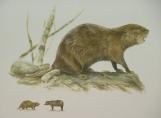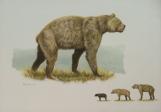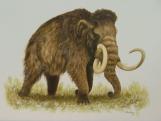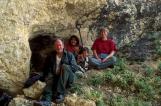1
CONTENTS:- Giant Animals of Beringia
- Hudé Hudän and Beringia Animals
- Mammoth Story #1
- Mammoth Story #2
- Mammoth Traps
- Giant Frogs and Worms
- Sioh Jhee and Giant Animals
2
Giant Animals of BeringiaDuring the last Ice Age, most of the snow that fell formed huge glaciers around the mountains. The mountain created a "rain shadow" in the surrounding areas, making them very dry. Forests could not grow there, so they became open grasslands that animals could graze on. Because of all this food, Beringia was home to many species of large animals.
Most Beringia animals were very large and stocky compared to their modern cousins. The mammoth, short-faced bear, and giant beaver are just a few examples of large animal species (or "megafauna"). Large, stocky bodies and heavy fur helped these animals survive the harsh climate of the Ice Age.
3
Beringian Giant Beaver, compared to modern bear belowDate not available
Beringia
 Credits:
Credits:(Courtesy Government of Yukon)
4
Shawn Charlie using an atlatl (spear thrower) and an LSCFN cultre camp2001
Manlena Män (Airport Lake)
 Credits:
Credits:(© Lee Carruthers 2001)
5
Hudé Hudän & Beringia AnimalsWhile most species of Beringia animals went extinct not long after the last Ice Age ended, some may have survived for quite awhile.
Elders tell many stories of big animals that were seen by their ancestors. The Woolly Mammoth was frequently spoken of by LSCFN elders. Some stories referred to other large creatures like the giant frog (tsal), worm (gum), owl (meddhing) and wolverine (naye). The Sasquatch was also frequently remembered by Northern Tutchone people of Carmacks.
8
Mammoth Story #1 (from Charlie et.al 2003)"This story takes place in the winter time. A family lived about halfway down Frenchman Lake. The husband of the daughter had gone down to the north end of the lake to visit his family there. The man's wife and her young twin brothers saw something coming away down on the ice. Thinking that it was their brother-in-law, they ran down the trail to meet him. Their sister, the man's wife, walked behind. As the shape got closer they realized that it wasn't a man but a very large animal.
It was too late for the two boys. The animal killed and ate them. Their sister saw what happened and hid under the snow until the animal passed by. Then she got up and ran around to their trail in the bush until she caught up to her older brother and father who were running rabbit snares. She told them what happened and they ran back to their home.
In those days they had houses made of brush and moss piled all around poles that they set up in the ground. The door was from the top to the house. Water was poured down the sides of the house to make a coating of ice all around to keep the house warm inside. The father cut a large pole and sharpened the end. He then hid away in the bushes. The big animal came up the trail from the lake to the house where the man's son was waiting on top of the ice house. The son clubbed the animal from the top of roof over and over again. The big animal couldn't climb up to get that man because the sides of the house were slippery from the ice. All the time he was doing this, his father jumped out from the bushes and speared the big animal in the soft place behind his front legs and killed him. They cut the big animal open right there and took out the bones of the people that the big animal had eaten. They took the people's bones and made a good fire to burn them. In the old days, when people died, their bodies had to be cremated so that their spirits could be born again.
Maybe the big animal was a wooly mammoth ("Ok'ena zan jhek"). That's how people talk about it, but nobody knows why it started eating people. People say you can still see the bones of this animal in Frenchman Lake".
9
Mammoth Story #2 (from Gotthardt, 1986)A mammoth had killed some people there, on the north end of the Frenchman Lake. On the other end of the lake, one old man stayed with lots of kids, hunting rabbits. His oldest daughter was married to the son of the people who were camped on the north end of Frenchman. He had gone to visit his family when the mammoth came and killed them all. The girl went looking for her husband and saw the mammoth. She ran back and told her brother. They both saw the mammoth on the trail to their camp, close by, and they ran. They had no time to tell their brothers or sisters who were staying in the tents in camp. The mammoth came and killed everyone there. It then put them back in their blankets so it looked like they were sleeping. Then the mammoth went inside to sleep too.
The girl and her brother met up with their father coming back from trapping and told him what happened. The old man cut a long pole and sharpened one end really sharp. Then he went to the camp with his son. He told his daughter to stay up on the hill and watch for a smoke signal, that would mean everything was alright.
When the old man got to camp, everything was real quiet. He climbed on top of the tent with his spear and told his son to run around the tent so that the mammoth would chase him. When the boy got tired, he jumped up on the tent with his father. The mammoth tried to jump up too, but the old man appeared then. Then he jumped down and cut him open before he could get up again.
10
Mammoth TrapsElder Wilfred Charlie described how to build and trap a mammoth with snares and deadfalls:
The snare or trigger is a line made of babiche crocheted together. This is strung among some trees, which have been cut part way through. When the mammoth comes through the trees, the line pulls all the trees down on him. Clubs were used to kill the mammoth then.
This technique for snaring mammoth is identical to traditional elephant hunting techniques used by African people. An exhibit of the mammoth trap is on display at the Tagé Cho Hudän Interpretive Centre in Carmacks.
According to Wilfred, one time, when people snared a mammoth, its foot was thumping on the ground while he was pinned under the trees. People made him turn his foot over. If the foot points down, it means that people are going to die. When the foot points the other way, it means that people are going to live.
12
Giant Frogs and WormsNorthern Tutchone people tell other stories about other large animals, too. One of the best known is about the Giant Frog that lived near Carmacks at Ts'äl Cho An ("Giant Frog Den"- known as Eagle Rock in English):
"People were scared of it and lay down on their rafts when they floated past on the river. If any noise was made going past on the river, it would cause a big wind to come up from the rock. People use to hide their children under blankets and told them to be quiet for about a mile upriver and downriver of Eagle Rock. Sometimes, if the frog saw people coming, he would jump on the raft and tip the people into the water. But it died in the big fire too".
Another story tells of a Giant Worm that lives at Gum Tthi ("Worm Rock" - Tantalus Butte or Coalmine Hill in English):
"Long time ago, before the white man or anything, a big worm lived under the ground in Coalmine Hill. When people went past on the river, they were very quiet so as not to awake the worm. If he found out someone was coming, he would roar and shake the ground. People were afraid to go up there, because they didn't know what made that noise. Then there was a fire. Everything burned and people had to stay on islands. The hill is made of coal and it burned way down deep. After that, that thing hollered no more".
13
Sioh Jhee & Giant AnimalsThere are many Northern Tutchone stories about Sioh Jhee, also known as Smart Man or Beaver Man. Here is a part of one that involves Giant Animals:
"A long time ago, many animals were much larger than they are today and they ate people. They were bad animals. Bear, eagle and coyote were all huge and ate people. Sioh Jhee set out to fix that. Here is the story of how he changed the eagles.
The eagles were killing and eating lots of people. Then the eagles were huge and their babies were the size adult eagles are now. Sioh Jhee made a sharp stick and climbed high in a tree where the eagles had their nest. The parents were away so he talked to the babies.
"Which one of you is a tattle tale?" he asked. The brother pointed to his sister. Sioh Jhee quickly killed her and gave the brother a gopher to eat as a reward for telling him. "How do you know when your mother and father are coming?" he asked.
"When my mother comes there is warmth and sunshine. "When my father comes there is a hailstorm, "replied the boy eagle. Sioh Jhee took his sharp stick and hid under the nest.
Then the mother arrived carrying a human body.
"I have fresh meat, "she said. "Where is your sister?"
"She had a headache and flew down to the creek to get some water," replied the boy eagle.
Just then, Sioh Jhee stabbed the mother eagle from under the nest, killing her. He threw that eagle away. Then there was a hail storm and the father eagle arrived carrying another human body. "Where are your mother and sister?" he demanded. "They both had headaches and flew down to the creek for water." Sioh Jhee stabbed through the nest again, killing the father eagle. He told the baby eagle,
"Now you will stay the size you are, and eat only gophers, rabbits, grouse and fish. Don't eat people anymore."


